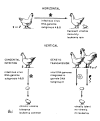The discovery of endogenous retroviruses
- PMID: 17018135
- PMCID: PMC1617120
- DOI: 10.1186/1742-4690-3-67
The discovery of endogenous retroviruses
Abstract
When endogenous retroviruses (ERV) were discovered in the late 1960s, the Mendelian inheritance of retroviral genomes by their hosts was an entirely new concept. Indeed Howard M Temin's DNA provirus hypothesis enunciated in 1964 was not generally accepted, and reverse transcriptase was yet to be discovered. Nonetheless, the evidence that we accrued in the pre-molecular era has stood the test of time, and our hypothesis on ERV, which one reviewer described as 'impossible', proved to be correct. Here I recount some of the key observations in birds and mammals that led to the discovery of ERV, and comment on their evolution, cross-species dispersion, and what remains to be elucidated.
Figures




References
-
- Baltimore D. Tumor viruses: 1974. 1975;39:1187–1200. - PubMed
Publication types
MeSH terms
LinkOut - more resources
Full Text Sources
Other Literature Sources

